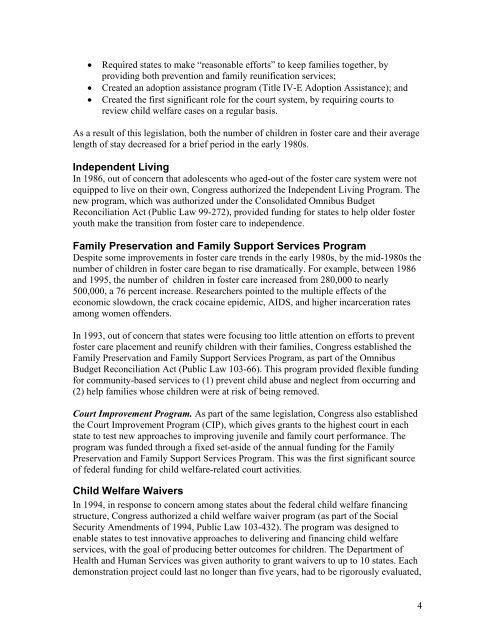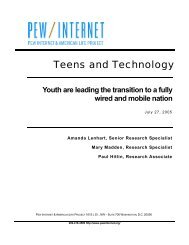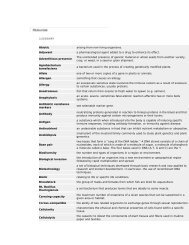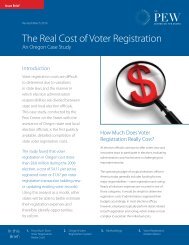Report: A Brief Legislative History of the Child Welfare System
Report: A Brief Legislative History of the Child Welfare System
Report: A Brief Legislative History of the Child Welfare System
Create successful ePaper yourself
Turn your PDF publications into a flip-book with our unique Google optimized e-Paper software.
• Required states to make “reasonable efforts” to keep families toge<strong>the</strong>r, by<br />
providing both prevention and family reunification services;<br />
• Created an adoption assistance program (Title IV-E Adoption Assistance); and<br />
• Created <strong>the</strong> first significant role for <strong>the</strong> court system, by requiring courts to<br />
review child welfare cases on a regular basis.<br />
As a result <strong>of</strong> this legislation, both <strong>the</strong> number <strong>of</strong> children in foster care and <strong>the</strong>ir average<br />
length <strong>of</strong> stay decreased for a brief period in <strong>the</strong> early 1980s.<br />
Independent Living<br />
In 1986, out <strong>of</strong> concern that adolescents who aged-out <strong>of</strong> <strong>the</strong> foster care system were not<br />
equipped to live on <strong>the</strong>ir own, Congress authorized <strong>the</strong> Independent Living Program. The<br />
new program, which was authorized under <strong>the</strong> Consolidated Omnibus Budget<br />
Reconciliation Act (Public Law 99-272), provided funding for states to help older foster<br />
youth make <strong>the</strong> transition from foster care to independence.<br />
Family Preservation and Family Support Services Program<br />
Despite some improvements in foster care trends in <strong>the</strong> early 1980s, by <strong>the</strong> mid-1980s <strong>the</strong><br />
number <strong>of</strong> children in foster care began to rise dramatically. For example, between 1986<br />
and 1995, <strong>the</strong> number <strong>of</strong> children in foster care increased from 280,000 to nearly<br />
500,000, a 76 percent increase. Researchers pointed to <strong>the</strong> multiple effects <strong>of</strong> <strong>the</strong><br />
economic slowdown, <strong>the</strong> crack cocaine epidemic, AIDS, and higher incarceration rates<br />
among women <strong>of</strong>fenders.<br />
In 1993, out <strong>of</strong> concern that states were focusing too little attention on efforts to prevent<br />
foster care placement and reunify children with <strong>the</strong>ir families, Congress established <strong>the</strong><br />
Family Preservation and Family Support Services Program, as part <strong>of</strong> <strong>the</strong> Omnibus<br />
Budget Reconciliation Act (Public Law 103-66). This program provided flexible funding<br />
for community-based services to (1) prevent child abuse and neglect from occurring and<br />
(2) help families whose children were at risk <strong>of</strong> being removed.<br />
Court Improvement Program. As part <strong>of</strong> <strong>the</strong> same legislation, Congress also established<br />
<strong>the</strong> Court Improvement Program (CIP), which gives grants to <strong>the</strong> highest court in each<br />
state to test new approaches to improving juvenile and family court performance. The<br />
program was funded through a fixed set-aside <strong>of</strong> <strong>the</strong> annual funding for <strong>the</strong> Family<br />
Preservation and Family Support Services Program. This was <strong>the</strong> first significant source<br />
<strong>of</strong> federal funding for child welfare-related court activities.<br />
<strong>Child</strong> <strong>Welfare</strong> Waivers<br />
In 1994, in response to concern among states about <strong>the</strong> federal child welfare financing<br />
structure, Congress authorized a child welfare waiver program (as part <strong>of</strong> <strong>the</strong> Social<br />
Security Amendments <strong>of</strong> 1994, Public Law 103-432). The program was designed to<br />
enable states to test innovative approaches to delivering and financing child welfare<br />
services, with <strong>the</strong> goal <strong>of</strong> producing better outcomes for children. The Department <strong>of</strong><br />
Health and Human Services was given authority to grant waivers to up to 10 states. Each<br />
demonstration project could last no longer than five years, had to be rigorously evaluated,<br />
4
















